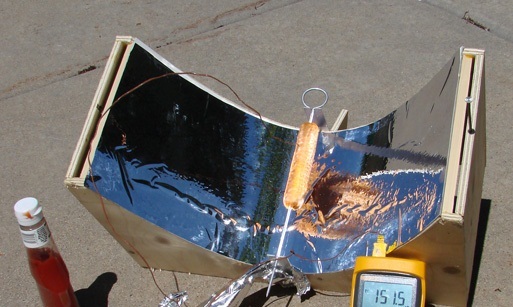Build a solar cooker
Build a cardboard solar cooker to heat snacks or melt marshmallows using sunlight; learn about reflection, insulation, and safe sun powered cooking techniques.



Step-by-step guide to build a cardboard solar cooker
How To Make Solar Cooker Project | Solar Cooker Model | School Project Working Model Of Solar Cooker
Step 1
Find a sunny flat spot outside and set the closed cardboard box there.
Step 2
Cut three sides of the top of the box so one flap stays attached at the back to act as a reflector.
Step 3
Smoothly tape aluminum foil to the underside of the flap with the shiny side facing out.
Step 4
Tape black construction paper to the bottom inside of the box to make a dark heat-absorbing surface.
Step 5
Tape aluminum foil to the inside back wall of the box with the shiny side facing in to help reflect sunlight onto the bottom.
Step 6
Stuff crumpled newspaper or a towel around the inside edges of the box to add insulation.
Step 7
Cover the open top of the box with clear plastic wrap and tape the edges tightly to create a sealed transparent window.
Step 8
Tilt and prop the foil flap so it reflects sunlight straight onto the black paper inside the box.
Step 9
With an adult, place the oven safe tray with your marshmallows or snack on the black paper inside the box and close the plastic window.
Step 10
Ask your adult to check the snack every 10 to 20 minutes until warm or melted and then share your finished solar cooker and what happened to your snack on DIY.org
Final steps
You're almost there! Complete all the steps, bring your creation to life, post it, and conquer the challenge!


Help!?
What can we use instead of aluminum foil, black construction paper, or plastic wrap if we can't find them?
If you don't have aluminum foil for the reflector you can tape on a shiny emergency blanket sheet or a clean reflective baking pan, substitute black paint or a dark towel for the black construction paper on the bottom, and use a clear oven bag or a tightly sealed large zip-top bag in place of the plastic wrap window.
My solar cooker isn't getting warm or the marshmallows aren't melting—what should I check and fix?
Make sure the foil is taped smoothly with the shiny side facing out and the back foil facing in, the flap is tilted to reflect direct sunlight onto the black paper, the plastic wrap window is sealed tightly with tape to trap heat, and the crumpled newspaper or towel insulation fills the edges so no air leaks cool the box.
How can I adapt this project for different ages so it's safe and fun?
For younger children have an adult pre-cut the box and attach foil and plastic while the child stuffs newspaper and watches, for elementary kids let them do the cutting and taping with supervision and check snacks every 10–20 minutes, and for teens add tasks like angle measurements and temperature logging with a cooking thermometer.
What are some ways to improve or personalize the solar cooker after we build it?
To enhance the cooker add a cooking thermometer on the black paper to record temperatures, create a double-layer plastic window for better insulation, decorate the outside of the box, and experiment with adjusting the foil flap angle to maximize sunlight and speed up melting.
Watch videos on how to build a cardboard solar cooker
Little Scientist #6: Homemade Solar Oven
Facts about solar energy and solar cooking
☀️ On a clear day, sunlight gives about 1,000 watts per square meter — plenty to heat a small cardboard cooker!
♻️ Solar cookers use no fuel and can help reduce wood gathering and smoke from traditional cooking.
⚠️ Concentrated reflections can burn — never look at focused sunlight and use oven mitts for hot food.
🍫 A foil‑lined cardboard cooker can melt chocolate or marshmallows in just a few sunny minutes.
🔥 Some solar cookers can reach temperatures above 200°C (392°F), hot enough to bake or fry with focused light.
How do I build a cardboard solar cooker to heat snacks or melt marshmallows?
What materials do I need to make a cardboard solar cooker?
What ages is this solar cooker activity suitable for?
Is building a cardboard solar cooker safe and what are the benefits or variations?


One subscription, many ways to play and learn.
Only $6.99 after trial. No credit card required



